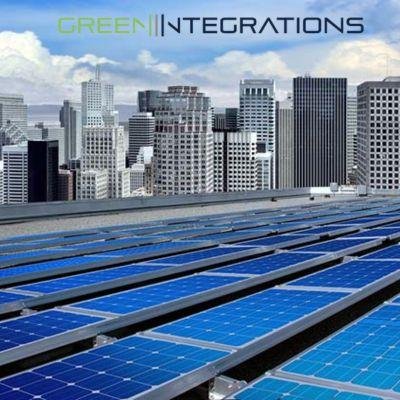-
Nieuws Feed
- EXPLORE
-
Blogs
A Complete Guide to Solar Panels for Commercial Buildings

As Canadian businesses aim for sustainability and long-term cost savings, renewable energy solutions like solar are becoming increasingly popular. One of the most practical and impactful changes a company can make is installing solar panels on their commercial property. In this comprehensive guide, we’ll walk you through everything you need to know about solar panels for commercial buildings—from how they work to the benefits, installation process, and financial considerations.
Why Solar Energy Makes Sense for Commercial Buildings
Commercial buildings typically consume large amounts of electricity for lighting, heating, cooling, and equipment. As utility costs rise and carbon emissions become a greater concern, many businesses are turning to solar energy as a sustainable alternative. Solar panels allow commercial property owners to generate their own electricity, reducing reliance on the grid and lowering monthly bills.
Environmental Impact
Installing solar panels is a tangible step towards reducing your company’s carbon footprint. With Canada’s commitment to achieving net-zero emissions by 2050, businesses are under more pressure than ever to reduce greenhouse gas output. Solar power produces clean, renewable energy that helps meet sustainability goals without compromising daily operations.
Long-Term Financial Benefits
While the initial investment can be significant, solar panels often pay for themselves over time through energy savings. Many commercial installations break even within 5 to 7 years, after which the system continues to generate virtually free power for another 20–30 years. Incentives like government grants, tax credits, and rebates can further reduce upfront costs.
How Solar Panels Work on Commercial Buildings
Solar panels convert sunlight into electricity through photovoltaic (PV) cells. These panels are typically installed on the roof or an open area of the property with direct sunlight exposure. A solar inverter then transforms the DC electricity generated by the panels into AC electricity that can be used by the building’s systems.
System Components
-
Solar panels: Capture sunlight and convert it into DC electricity.
-
Inverter: Converts DC into usable AC electricity.
-
Mounting system: Secures panels to the roof or ground.
-
Monitoring system: Tracks energy output and system performance.
-
Battery storage (optional): Stores excess power for use during outages or peak hours.
Factors to Consider Before Installation
Before investing in solar panels for commercial buildings, it’s important to assess whether your site is suitable. Factors like roof size, sun exposure, local weather, and structural integrity play a big role in system performance.
Site Assessment
A professional assessment will evaluate:
-
Roof condition and orientation
-
Shading from trees or nearby buildings
-
Electrical infrastructure
-
Potential for battery storage or expansion
Regulatory and Permitting Requirements
In Canada, building permits, electrical inspections, and utility approvals are often required for commercial solar installations. Working with a knowledgeable provider ensures compliance with provincial and municipal regulations.
Financial Considerations
The cost of solar panels for commercial buildings varies based on system size, location, and technology used. Fortunately, there are several financing options and incentives available to Canadian businesses.
Incentives and Rebates
Depending on your province, you may be eligible for:
-
Federal or provincial tax credits
-
Capital cost allowances (CCA)
-
Clean Energy Initiatives and grants
-
Net metering programmes
These incentives significantly reduce the net cost of the system and improve return on investment.
Financing Options
-
Outright Purchase: Best for companies with upfront capital.
-
Solar Lease or Power Purchase Agreement (PPA): Pay a fixed rate for solar energy without owning the system.
-
Loan Financing: Spread the cost over several years while benefiting from immediate energy savings.
Maintenance and Monitoring
Modern solar systems require minimal maintenance. Regular cleaning and periodic inspections are usually sufficient to keep them running efficiently.
Ongoing Monitoring
Monitoring platforms allow business owners to track system performance, energy output, and financial savings in real-time. Many commercial solar providers offer maintenance packages to ensure peak efficiency over the life of the system.
Choosing the Right Provider
Working with a reputable solar energy company is critical to ensuring a smooth and successful installation. Look for providers with experience in commercial projects, strong customer reviews, and transparent pricing.
Key Questions to Ask
-
How many commercial installations have you completed?
-
What warranties do you offer?
-
Do you handle permitting and utility approvals?
-
What type of post-installation support is provided?
The Future of Solar for Canadian Businesses
Solar energy is not just a trend—it’s a long-term solution to rising energy costs and environmental concerns. As technology advances and prices continue to drop, more businesses are expected to adopt solar panels for commercial buildings. By acting now, you can position your business ahead of the curve and demonstrate leadership in sustainability.
Conclusion: Take the Next Step Toward Energy Independence
Investing in solar panels for commercial buildings is a strategic move that delivers both environmental and financial returns. With the right system and provider, your business can reduce energy costs, improve sustainability credentials, and take control of its power needs.
Green Integrations Inc. specialises in helping Canadian businesses make the transition to clean energy with reliable, high-performance solar solutions. Contact us today for a site assessment and customised solar proposal tailored to your commercial property.
FAQs
How long does it take to install solar panels on a commercial building?
Installation time varies based on system size and complexity but typically ranges from a few weeks to a couple of months, including permitting and inspections.
What happens if my solar panels produce more energy than I use?
Excess energy can be fed back into the grid through net metering programmes, earning you credits on your electricity bill.
Can I install solar panels if my roof isn’t in great shape?
It’s recommended to repair or replace aging roofs before installation. A solid foundation ensures the solar system remains secure and performs efficiently over time.





